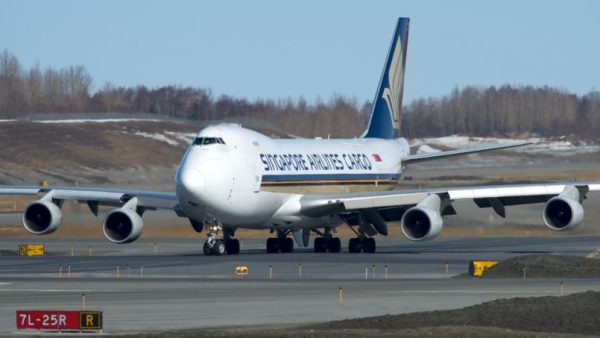
Ted Stevens Anchorage International Airport ranked as the fourth busiest in the world for cargo shipping in 2020.
A recent story in the Anchorage Daily News explained that the bump, up from sixth place, was due to increased demand for products from Asian countries, as Americans were spending more time at home during the pandemic.
The other part of that story, by ADN reporter Alex DeMarban, is about continuing efforts to capitalize on Anchorage’s strategic location. That includes projects to build huge new warehouses, a cold storage facility, expansions by FedEx and UPS and a maintenance hangar for jumbo jets.
And, whether it’s the airport’s current success or its future plans, DeMarban says there are some interesting aspects of its growing role as a major player in the cargo shipping world.
LISTEN HERE:
Read a full transcript of the conversation, with minor edits for clarity:
Alex DeMarban: Anchorage saw remarkable growth. It had 3.2 million metric tons landed or 3.5 million tons landed — that’s like 15% growth. And that really dramatically beat all the other competitors that are in the top 10. Memphis is number one, where FedEx has its headquarters. And they grew quite a bit too. But Hong Kong and Shanghai were second and third in 2020 and they did not grow very much. Anchorage just took off. So it just means the amount of pounds of cargo landed. And in Anchorage’s case, it’s not being transferred onto another airplane for the most part. It’s just sitting on an airplane and then the airplane gets fueled up and goes off to its next destination.
Casey Grove: What do they attribute that growth to in the last year?
Alex DeMarban: Of course, e-commerce is the big driving factor and just the demand in products from Lower 48ers trying to get products from Asian countries, like computers, cell phones, all those sorts of things. You can imagine lots of homebound, Lower 48ers wanting to spend the stimulus money and maybe get their kid a computer now that he’s no longer in school.
The Asia-to-US trade route is the busiest in the world. So as Americans wanted more, more products were coming through including, what I understand, increasingly from new cities in Asia that might stop in Hong Kong or Shanghai, they saw the benefit of coming through Anchorage increasingly, and bypassing those other big hubs in Hong Kong or Shanghai, and came right here.
Casey Grove: And I guess there are things that that the United States is shipping abroad too. Tell me about those.
Alex DeMarban: Some of the things that are moving that were described to me by the airport director would be like, some lobster from Nova Scotia, heading over to Chinese dinner tables. He described cherries from Washington state as a big seasonal product. And he even described sometimes planeloads of pigs to like China to replace swine-flu-killed pigs or virus-killed pigs, and they’re from the Midwest. And even racing horses will fly over if there’s a big event.
Casey Grove: Yeah, there’s kind of this funny part in your story where the airport director points out a plane, and he’s like, that’s the lobster plane right there.
Alex DeMarban: Right, exactly that SkyLease cargo jet comes out in Nova Scotia on occasion and will deliver live seafood like lobster. Of course, it carries other things too. And it sounds like the lobster nickname is kind of just what the airport folks generally call it. But of course, it’s carrying a lot of other stuff, too.
Casey Grove: You know, people have said for years that we’re at the crossroads in Anchorage of this global shipping route. And that benefits the folks that are shipping, how does that benefit us here?
Alex DeMarban: Well, I think the major benefit has so far not been felt — or not been felt as well as it could have. Because to me the potential could be entrepreneurs who can get their products here in Alaska to places elsewhere in the world more easily, including seafood and peonies flowers are always kind of a big thing that’s mentioned as another possibility.
I think then the other benefit now is the fees and profits generated at the airport, which is its own entity, as well as things like cargo pilots coming into the economy. I understand like 400 cargo pilots a night are renting hotel space. Those 400 rooms from cargo pilots are pretty substantial — that’s like two Midtown hotels, basically. And then they’re spending money in the economy, of course, at restaurants and elsewhere.
Casey Grove: You mentioned in your story that the Ted Stevens Anchorage International Airport, because of Ted Stevens, has some extra benefits that maybe other airports wouldn’t have? Remind me what that is and how that works.
Alex DeMarban: Sounds like in 1996 and 2004, Ted Stevens got these benefits through Congress, where the airport became a place where foreign carriers could transfer product directly among themselves. And that helps them save money on duties and also helps them better coordinate their shipping schedules.
Right now only two planes can do that at a time. So they’re lining up tail-to-tail out on the tarmac. And you can imagine, that’s a challenging thing to do. So if you had these warehouses, you wouldn’t have that problem. The product could just keep building up until the next plane, at a more convenient time, could come along later and grab it.
It’s interesting to think that we here in Anchorage could kind of help influence global shipping patterns. Because if, say, more airplanes come through here, directly traveling to more cities more efficiently in the Lower 48 that reduces the need for cargo to travel overland in trucks in the Lower 48. So what’s happening here can have a direct impact on other parts of the US economy and even the world economy. That’s kind of fascinating to think about.
Casey Grove is host of Alaska News Nightly, a general assignment reporter and an editor at Alaska Public Media. Reach him at cgrove@alaskapublic.org. Read more about Casey here.





